2018 MITSUBISHI OUTLANDER III engine overheat
[x] Cancel search: engine overheatPage 220 of 441

Tire pressure monitoring system
Features and controls 5-139
5
Each tire, including the spare (if provided),should be checked monthly when cold andinflated to the inflation pressure recom-mended by the vehicle manufacturer on thevehicle placard or tire
inflation pressure label.
(If your vehicle has tires of a different sizethan the size indicated on the vehicle placardor tire inflation pressure label, you shoulddetermine the proper ti
re inflation pressure
for those tires.)As an added safety feat
ure, your vehicle has
been equipped with a tire pressure monitoringsystem (TPMS) that illuminates a low tirepressure telltale when
one or more of your
tires is significantly under-inflated.Accordingly, when the low tire pressure tell-tale illuminates, you
should stop and check
your tires as soon as possible, and inflatethem to the proper pressure. Driving on a sig-nificantly under-inflated
tire causes the tire to
overheat and can lead
to tire failure.
Under-inflation also reduces fuel efficiencyand tire tread life, and may affect the vehi-cle’s handling and stoppi
ng ability. Please
note that the TPMS is
not a substitute for
proper tire maintenance, and it is the driver’sresponsibility to
maintain corre
ct tire pres-
sure, even if under-infl
ation has not reached
the level to trigger illumination of the TPMSlow tire pressure telltale.Your vehicle has also
been equipped with a
TPMS malfunction indica
tor to indicate when
the system is not operating properly. TheTPMS malfunction indicator is combinedwith the low tire pressure telltale.When the system detects a malfunction, thetelltale will flash for approximately one min-ute and then remain c
ontinuously illuminated.
This sequence will c
ontinue upon subsequent
vehicle start-ups as long as the malfunctionexists.When the malfunction indicator is illumi-nated, the system may not
be able to detect or
signal low tire pr
essure as intended.
TPMS malfunctions ma
y occur for a variety
of reasons, including the installation ofreplacement or alternate tires or wheels on thevehicle that prevent the TPMS from function-ing properly. Always
check the TPMS mal-
function telltale after
replacing one or more
tires or wheels on your vehicle to ensure thatthe replacement or alternate tires and wheels
CAUTIONIf the tire pressure monitoring system warn-ing light does not illumi
nate when the igni-
tion switch is turned to the “ON” position orthe operation mode is put in ON, it meansthat the tire pressure monitoring system isnot working properly. Have the systeminspected by an authorized MitsubishiMotors dealer.In such situations, a malfunctioning of thesystem may be preventing the monitoring ofthe tire pressure. Avoid sudden braking,sharp turning and high-speed driving.If a malfunction is detected in the tire pres-sure monitoring system, the tire pressuremonitoring system warning light will blinkfor approximately 1 mi
nute and then remain
continuously illuminate
d. The warning light
will issue further warnings each time theengine is restarted as
long as the malfunction
exists.Check to see whether the warning light goesoff after few minutes driving.If it then goes off during driving, there is noproblem.However, if the warning light does not gooff, or if it blinks again when the engine isrestarted, have the
vehicle inspected by an
authorized Mitsubish
i Motors dealer.
In such situations, a malfunctioning of thesystem may be preventing the monitoring ofthe tire pressure. For safety reasons, whenthe warning light appears while driving,avoid sudden braking, sharp turning andhigh-speed driving.
NOTE
In addition, the warni
ng display is displayed
on the information screen in the multi-infor-mation display.
BK0249100US.book 139 ページ 2017年5月10日 水曜日 午前8時49分
Page 243 of 441
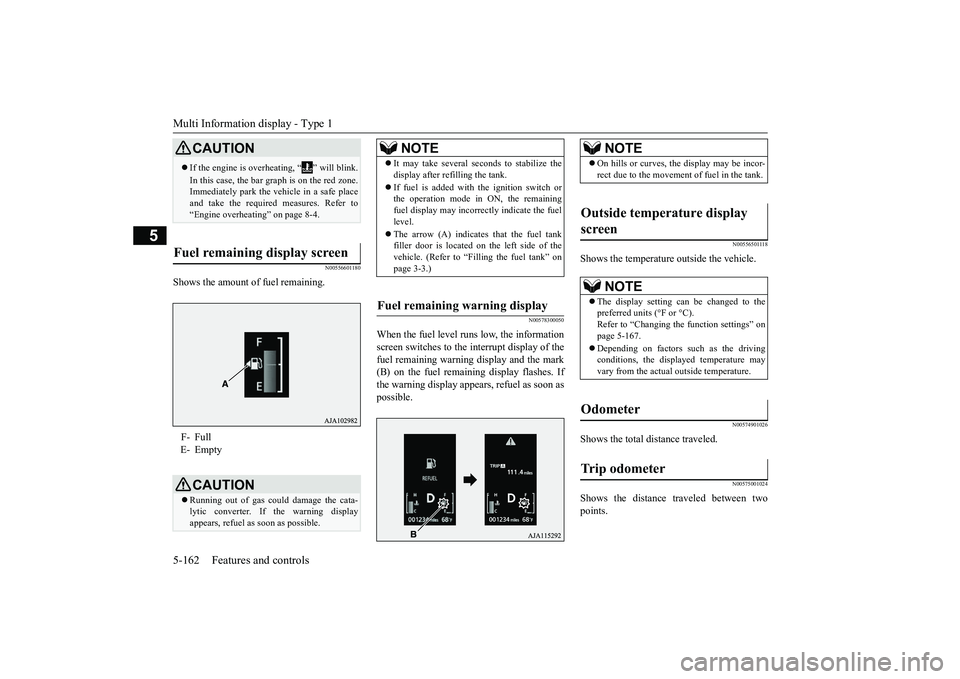
Multi Information display - Type 15-162 Features and controls
5
N00556601180
Shows the amount of fuel remaining.
N00578300050
When the fuel level runs low, the informationscreen switches to the interrupt display of thefuel remaining warning display and the mark(B) on the fuel remaini
ng display flashes. If
the warning display appear
s, refuel as soon as
possible.
N00556501118
Shows the temperature outside the vehicle.
N00574901026
Shows the total distance traveled.
N00575001024
Shows the distance traveled between twopoints.
CAUTIONIf the engine is overheating, “ ” will blink.In this case, the bar graph is on the red zone.Immediately park the vehicle in a safe placeand take the require
d measures. Refer to
“Engine overheating” on page 8-4.
Fuel remaining display screen F- FullE- Empty
CAUTIONRunning out of gas coul
d damage the cata-
lytic converter. If the warning displayappears, refuel as soon as possible.
NOTE
It may take several se
conds to stabilize the
display after re
filling the tank.
If fuel is added with
the ignition switch or
the operation mode in ON, the remainingfuel display may incorre
ctly indicate the fuel
level.The arrow (A) indicates that the fuel tankfiller door is located on
the left side of the
vehicle. (Refer to “F
illing the fuel tank” on
page 3-3.)
Fuel remaining warning display
NOTE
On hills or curves, the display may be incor-rect due to the movement
of fuel in the tank.
Outside temperature display screen
NOTE
The display setting ca
n be changed to the
preferred units (°F or °C).
e function settings” on
page 5-167.Depending on factors such as the drivingconditions, the displa
yed temperature may
vary from the actual outside temperature.
Odometer Trip odometer
BK0249100US.book 162 ページ 2017年5月10日 水曜日 午前8時49分
Page 268 of 441
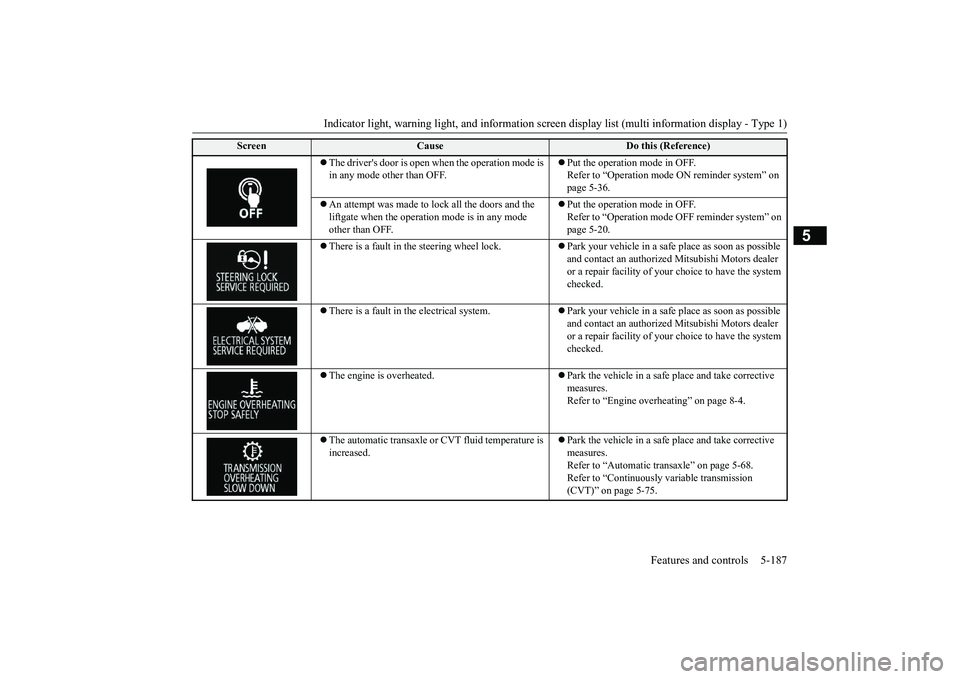
Indicator light, warning light, and information screen display list (multi information display - Type 1)
Features and controls 5-187
5
The driver's door is open when the operation mode is in any mode other than OFF.
Put the operation mode in OFF.Refer to “Operation mode
ON reminder system” on
page 5-36.
An attempt was made to lock all the doors and the liftgate when the operati
on mode is in any mode
other than OFF.
Put the operation mode in OFF.Refer to “Operation mode
OFF reminder system” on
page 5-20.
There is a fault in the steering wheel lock.
Park your vehicle in a safe
place as soon as possible
and contact an authorized
Mitsubishi Motors dealer
or a repair facility of your
choice to have the system
checked.
There is a fault in the electrical system.
Park your vehicle in a safe
place as soon as possible
and contact an authorized
Mitsubishi Motors dealer
or a repair facility of your
choice to have the system
checked.
The engine is overheated.
Park the vehicle in a safe place and take corrective measures.Refer to “Engine overh
eating” on page 8-4.
The automatic transaxle or CVT fluid temperature is increased.
Park the vehicle in a safe place and take corrective measures.Refer to “Automatic tr
ansaxle” on page 5-68.
Refer to “Continuously variable transmission (CVT)” on page 5-75.
Screen
Cause
Do this (Reference)
BK0249100US.book 187 ページ 2017年5月10日 水曜日 午前8時49分
Page 286 of 441

Warning lights
Features and controls 5-205
5
tion switch is turned to the “ON” position(engine off) or the operation mode is put inON. On vehicle equipped with the multiinformation display - Type 1, a warning isalso displayed in the multi information dis-play. When the engine is started, the lightshould go out. Check to make sure that thelight has gone out before driving.
N00520701278
This light comes on when the engine oil pres-sure is below normal. If the light stays onwhile driving, stop the engine as soon as pos-sible. Do not run the engine until the cause ofthe low oil pressure is corrected.
N00575701021
This light comes on in red if the coolant tem-perature becomes excessively high.
N00520901339
This light comes on when any door or the lift-gate is open or not completely closed.When the vehicle is moving at more than 5mph (8 km/h) and any door or the liftgate isopen or ajar, a tone will sound 4 times toinform the driver that any door or the liftgateis not properly shut.
CAUTIONIf the warning light stays on while the engineis running, park your ve
hicle in a safe place
as soon as possible and
contact an authorized
Mitsubishi Motors dealer
or a repair facility
of your choice to have the system checked.
Oil pressure warning light (Vehicle equipped with the multi information display - Type 2)
CAUTIONIf this light comes on when the engine oillevel is not low, have
your vehicle checked at
an authorized Mitsubish
i Motors dealer or a
repair facility
of your choice.
This warning light does not show the amountof oil in the crankcase. This can only bedetermined by checking the oil level with thedipstick with the engine turned off.
High coolant temperature warning light - red (Vehicle equipped with the multi infor-mation display - Type 2)
CAUTIONIf the light comes on
during vehicle opera-
tion, it indicates that
the engine is possibly
overheating. Continue
d driving could make
the engine fail. Immedi
ately stop the vehicle
in a safe place and ta
ke appropriate action.
(Refer to “Engine overh
eating” on page 8-4.)
NOTE
The high coolant temp
erature warning light
may illuminate when
the vehicle has been
driven at high speeds or on hilly roads. Thisilluminating does not ne
cessarily indicate a
problem. It should stop if you keep theengine running for a whil
e or continue driv-
ing the vehicle.
Door-ajar warning light and buzzer (Vehicle equipped with the multi information display - Type 2)
CAUTIONBefore driving, make sure that the door-ajarwarning light is off.
BK0249100US.book 205 ページ 2017年5月10日 水曜日 午前8時49分
Page 288 of 441
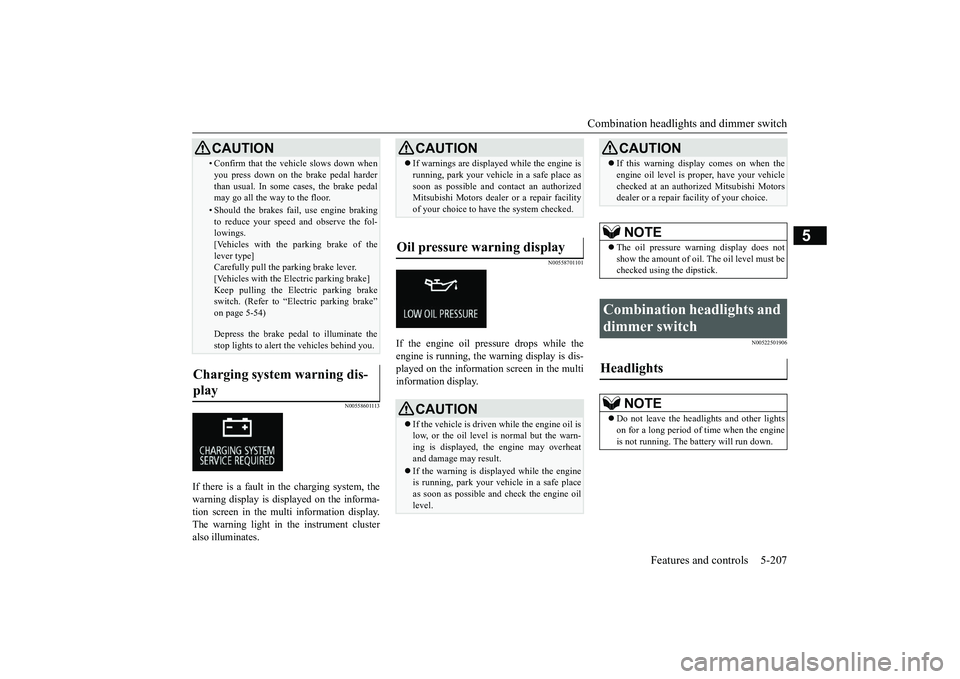
Combination headlights and dimmer switch
Features and controls 5-207
5
N00558601113
If there is a fault in the charging system, thewarning display is di
splayed on the informa-
tion screen in the multi information display.The warning light in the instrument clusteralso illuminates.
N00558701101
If the engine oil pressure drops while theengine is running, the
warning display is dis-
played on the information screen in the multiinformation display.
N00522501906
• Confirm that the vehicle slows down whenyou press down on the brake pedal harderthan usual. In some cases, the brake pedalmay go all the way to the floor.• Should the brakes fail, use engine brakingto reduce your speed and observe the fol-lowings.[Vehicles with the parking brake of thelever type]Carefully pull the pa
rking brake lever.
[Vehicles with the Electric parking brake]Keep pulling the Elec
tric parking brake
switch. (Refer to “Electric parking brake”Depress the brake pedal to illuminate thestop lights to alert th
e vehicles behind you.
Charging system warning dis-play
CAUTION
CAUTIONIf warnings are displaye
d while the engine is
running, park your vehicl
e in a safe place as
soon as possible and contact an authorizedMitsubishi Motors dealer
or a repair facility
of your choice to have the system checked.
Oil pressure warning display
CAUTIONIf the vehicle is driven while the engine oil islow, or the oil level is normal but the warn-ing is displayed, th
e engine may overheat
and damage may result.If the warning is displayed while the engineis running, park your ve
hicle in a safe place
as soon as possible and check the engine oillevel.
If this warning display comes on when theengine oil level is prope
r, have your vehicle
checked at an author
ized Mitsubishi Motors
dealer or a repair fa
cility of your choice.
NOTE
The oil pressure warning display does notshow the amount of oil. The oil level must bechecked using the dipstick.
Combination headlights and dimmer switch Headlights
NOTE
Do not leave the head
lights and ot
her lights
on for a long period of time when the engineis not running. The battery will run down.CAUTION
BK0249100US.book 207 ページ 2017年5月10日 水曜日 午前8時49分
Page 334 of 441

Driving during cold weather
Driving safety 6-5
6
you give extra attention to the followingareas, you can better protect yourself andyour passengers:Drive defensively. Be aware of traffic,road and weather c
onditions. Leave plenty
of stopping distance
between your vehicle
and the vehicle ahead.Before changing lanes, check your mir-rors, blind spots, a
nd use your turn-signal
light.While driving, watch the behavior ofother drivers, bicycl
ists, and pedestrians.
Always obey applicab
le laws and regula-
tions. Be a polite and alert driver. Alwaysleave room for unexpected events, such assudden braking.If you plan to drive in another country,obey their vehicle re
gistration laws and
make sure you will be able to get the rightfuel.
N00629400445
Check the battery. At the same time,check the terminals and wiring. Duringextremely cold weather, the battery willnot be as strong. Also, the battery powerlevel may drop beca
use more power is
used for cold starting and driving.
Before driving the vehicle, check to see ifthe engine runs at the proper speed and ifthe headlights are as bright as normally.Charge or replace the battery if necessary.During extreme cold weather, it is possi-ble that a very low battery could freeze.Warm the engine sufficiently. After start-ing the engine, allow a short warm-uptime to distribute oil to all cylinders. Thendrive your vehicle slowly.Stay at low speeds at first so that thetransaxle, transfer case and rear axle oilhave time to spread to all lubricationpoints.Check the engine antifreeze.If there is not enough coolant because of aleak or from engine
overheating, add Mit-
subishi Motors Genuine Super Long LifeCoolant Premium or equivalent.Please read this section in conjunctionwith the “Engine coolant” on page 9-8.
N00629501528
All the parts of the brake system are criticalto safety. Have the
vehicle serviced by an
authorized Mitsubishi Motors dealer or arepair facility of your
choice at regular inter-
vals according to the “WARRANTY ANDMAINTENANCE MANUAL”.Check the brake system while driving at alow speed immediately
after starting, espe-
cially when the brakes are wet, to confirmthey work normally.A film of water can be formed on the brakediscs and prevent normal braking after driv-ing in heavy rain or through large puddles, orafter the vehicle is washed. If this occurs, drythe brakes out by drivi
ng slowly while lightly
depressing the brake pedal.
Driving during cold weather
WA R N I N GThe battery gives off explosive hydrogengas. Any spark or flame can cause the bat-tery to explode, which could cause seriousinjury or death.Always wear protecti
ve clothes and a face
mask when working with your battery, orlet a skilled mechanic do it.
WA R N I N GNever open the radiator cap when theradiator is hot. You could be seriouslyburned.
Braking When brakes are wet
BK0249100US.book 5 ページ 2017年5月10日 水曜日 午前8時49分
Page 335 of 441
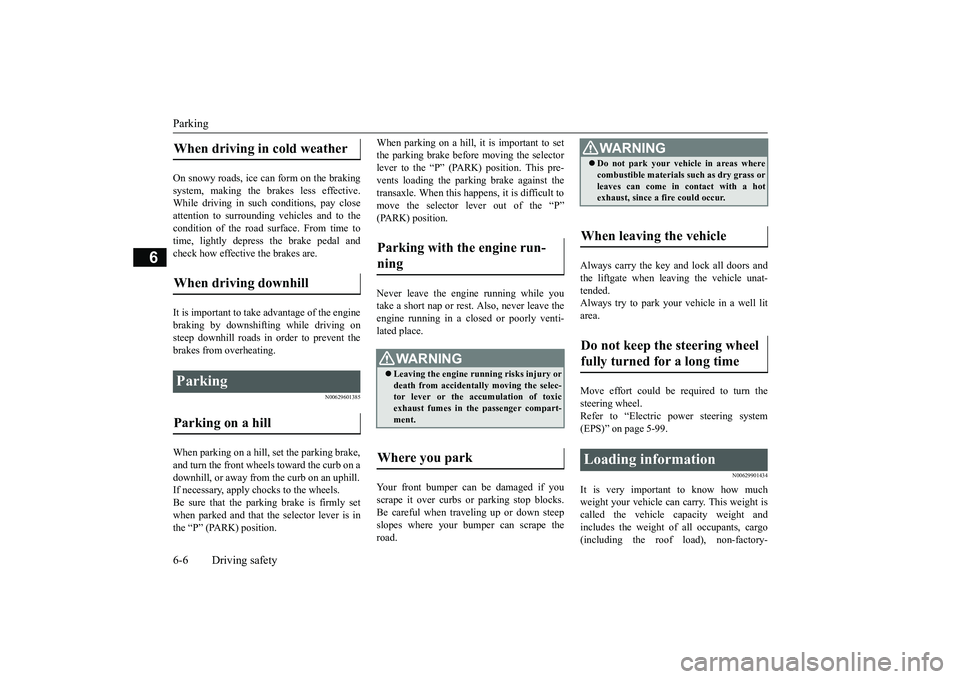
Parking6-6 Driving safety
6
On snowy roads, ice can form on the brakingsystem, making the brakes less effective.While driving in such conditions, pay closeattention to surrounding
vehicles and to the
condition of the road surface. From time totime, lightly depress the brake pedal andcheck how effective the brakes are.It is important to take
advantage of the engine
braking by downshifting while driving onsteep downhill roads in order to prevent thebrakes from overheating.
N00629601385
When parking on a hill, set the parking brake,and turn the front wheels toward the curb on adownhill, or away from
the curb on an uphill.
If necessary, apply chocks to the wheels.Be sure that the parki
ng brake is firmly set
when parked and that the selector lever is inthe “P” (PARK) position.
When parking on a hill, it is important to setthe parking brake befo
re moving the selector
lever to the “P” (PARK) position. This pre-vents loading the parking brake against thetransaxle. When this ha
ppens, it is difficult to
move the selector lever out of the “P”Never leave the engine running while youtake a short nap or rest. Also, never leave theengine running in a closed or poorly venti-lated place.Your front bumper can be damaged if youscrape it over curbs or parking stop blocks.Be careful when traveling up or down steepslopes where your bumper can scrape theroad.
Always carry the key and lock all doors andthe liftgate when leaving the vehicle unat-tended.Always try to park your vehicle in a well litarea.Move effort could be required to turn thesteering wheel.Refer to “Electric power steering system(EPS)” on page 5-99.
N00629901434
It is very important to know how muchweight your vehicle can carry. This weight iscalled the vehicle ca
pacity weight and
includes the weight of
all occupants, cargo
(including the roof load), non-factory-
When driving in cold weather When driving downhill Parking Parking on a hill
Parking with the engine run-ning
WA R N I N GLeaving the engine ru
nning risks injury or
death from accidentally moving the selec-tor lever or the accumulation of toxicexhaust fumes in the passenger compart-ment.
Where you park
WA R N I N GDo not park your vehicle in areas wherecombustible materials
such as dry grass or
leaves can come in contact with a hotexhaust, since a fire could occur.
When leaving the vehicle Do not keep the steering wheel fully turned for a long time Loading information
BK0249100US.book 6 ページ 2017年5月10日 水曜日 午前8時49分
Page 344 of 441
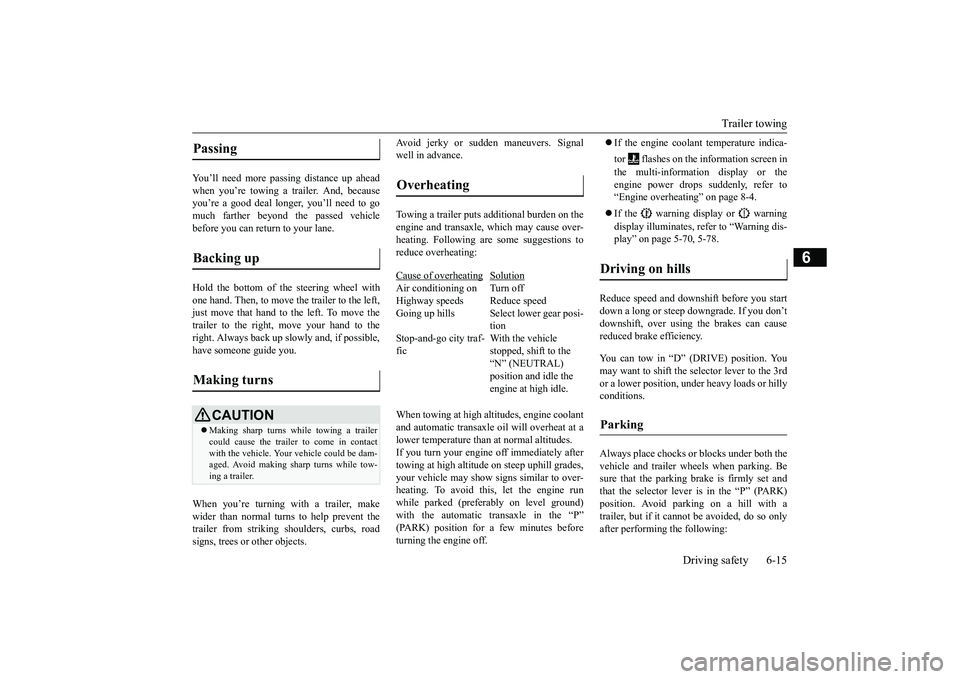
Trailer towing
Driving safety 6-15
6
You’ll need more passing distance up aheadwhen you’re towing a trailer. And, becauseyou’re a good deal longer, you’ll need to gomuch farther beyond the passed vehiclebefore you can return to your lane.Hold the bottom of the steering wheel withone hand. Then, to move the trailer to the left,just move that hand to the left. To move thetrailer to the right, move your hand to theright. Always back up sl
owly and, if possible,
have someone guide you.When you’re turning with a trailer, makewider than normal turns to help prevent thetrailer from striking shoulders, curbs, roadsigns, trees or other objects.
Avoid jerky or sudden maneuvers. Signalwell in advance.Towing a trailer puts additional burden on theengine and transaxle,
which may cause over-
heating. Following ar
e some suggestions to
reduce overheating:When towing at high al
titudes, engine coolant
and automatic transaxle oil will overheat at alower temperature than at normal altitudes.If you turn your engine off immediately aftertowing at high altitude
on steep uphill grades,
your vehicle may show
signs similar to over-
heating. To avoid this
, let the engine run
while parked (preferably on level ground)with the automatic transaxle in the “P”turning the engine off.
If the engine coolant temperature indica-tor flashes on the information screen inthe multi-information display or theengine power drops suddenly, refer to“Engine overheati
ng” on page 8-4.
If the warning display or warningdisplay illuminates, re
fer to “Warning dis-
play” on page 5-70, 5-78.
Reduce speed and downshift before you startdown a long or steep downgrade. If you don’tdownshift, over using the brakes can causereduced brake efficiency.You can tow in “D” (DRIVE) position. Youmay want to shift the selector lever to the 3rdor a lower position, under heavy loads or hillyconditions.Always place chocks or blocks under both thevehicle and trailer wheels when parking. Besure that the parking brake is firmly set andthat the selector lever is in the “P” (PARK)position. Avoid parki
ng on a hill with a
trailer, but if it cannot be avoided, do so onlyafter performing the following:
Passing Backing up Making turns
CAUTIONMaking sharp turns while towing a trailercould cause the
trailer to come in contact
with the vehicle. Your
vehicle could be dam-
aged. Avoid making sharp turns while tow-ing a trailer.
Overheating Cause of overheating
Solution
Air conditioning on Turn offHighway speeds Reduce speedGoing up hills Select lower gear posi-
tion
Stop-and-go city traf-fic
With the vehicle stopped, shift to the “N” (NEUTRAL) position and idle the engine at high idle.
Driving on hills Parking
BK0249100US.book 15 ページ 2017年5月10日 水曜日 午前8時49分